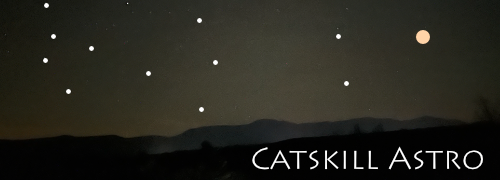Arp’s Peculiar Galaxies
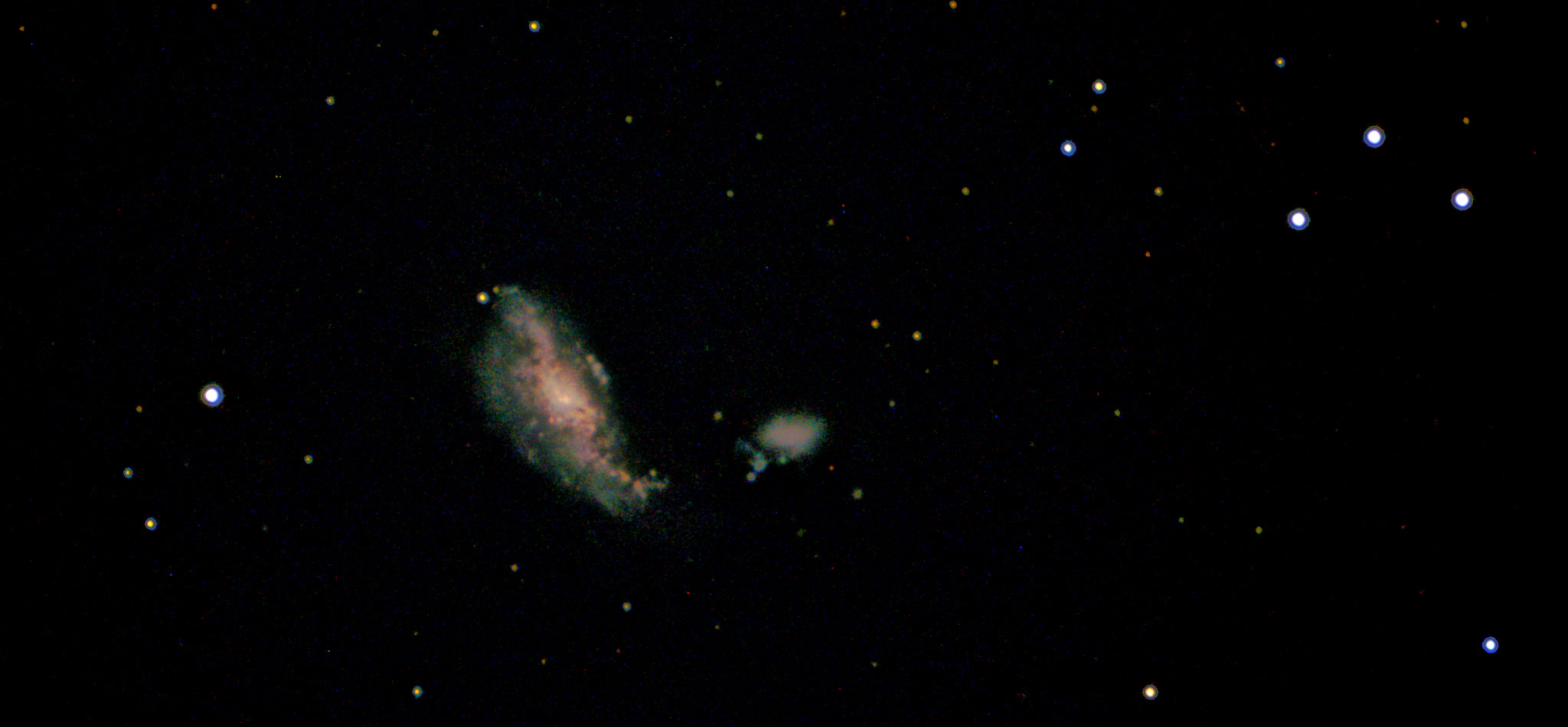
Page 4 of 16
Arp observations 31-40 of 155 total to date.
| Thumbnail | Title/link | Arp Category | Date Observed | Observer Description |
|---|---|---|---|---|
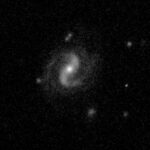 |
Arp 73 / IC 1222 | Spiral galaxies with small high surface brightness companions on arms | 2024-10-28 21:40:00 | This is an attractive barred spiral galaxy, probably SBb following the Hubble classification scheme. Categorized by Arp as a galaxy with SMALL, high surface brightness companions, the first task is to decide what small objects are galaxies and which are stars. For this I relied mostly on my own inverted image (second in the gallery). In my analysis, the only object I can identify reliably as a galaxy is the object towards the bottom center of the image. The broad sweep of the northern arm points to it and seems to make contact (or nearly so). The next object at the same level to the right (southward) is possibly a small galaxy, but given the noise in this image I can't be sure. There are two additional objects that appear in my inverted image to be dim galaxy smudges: one in the far NW (lower left) corner, and the other to the far south (right) border even with the top of the disk. Neither seems to interact with Arp 73. The remaining bright objects, all even with or above the disk, including the binary pair, appear to be field stars. |
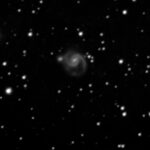 |
Arp 74 / UGC 1626 | Spiral galaxies with small high surface brightness companions on arms | 2024-12-26 18:45:00 | Arp 74 consists of UGC 1626 (Mag 14.1), the barred spiral at the center and Arp 74B (2MASX J02082216+4128061) the small spiral galaxy (Mag. 15.7!) above it in the comparison image). The key question is whether we're viewing an attraction, with a 74B about to be absorbed, or an asterism with 74B representing a much more distant galaxy with no gravitational connection. Arp clearly concluded the former, presumably because of the slight, triangular bump in the arm of UGC 1626 adjacent to its companion. Overall, I think Arp may have made a mistake and that this is an asterism. If it were so close by, I think spiral arm would be even more distorted. Also, Arp may have missed at least one "low surface brightness" companion, and possibly two. The most attracting is the faint spot east (left) in the comparison image. This appears to be the target of the lower, curving arm of galaxy UGC 1626. The second is an even fainter dot, barely visible in my image, close to the main arm, on a direct line between the first faint companion and 74B. This may explain why dust lanes curve upward and leftward from the top arm, creating an illusion that 74B is also gravitationally interacting with 74. |
 |
Arp 76 / M90 | Spiral galaxies with small high surface brightness companions on arms | 2024-03-13 13:32:42 | The seventh of 9 entries added to the Messier catalog on March 8, 1781, also (#40) credited to Messier. "Nebula without star, in Virgo: its light is as faint as the preceding, No. 89." Halton Arp selected M90 for his Atlas of Peculiar Galaxies, categorizing "high surface companions on arms" as the peculiarity <--> Final observation of a very successful evening, completed around 1 AM. As expected for a Messier object, compared to most Arp galaxies, it is very bright. As Arp comments, IC 3583 is indeed a high surface brightness companion, though relatively distant from M90 compared to some other Arp "companions". Interactions are evident in the expansion and curvature towards IC 3583 of the NW arm, as well as a subtle dust lane that appears to connect them. This is much more evident in the inverted image compared to the color one. |
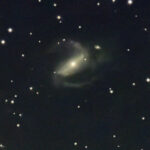 |
Arp 77 / NGC 1097 / C 67 | Spiral galaxies with small high surface brightness companions on arms | 2025-09-27 05:44:00 | This was an unplanned, unexpected observation. I woke up at 4:50 AM and noticed the skies were clear. Looked in SkySafari at the unobserved objects in the Caldwell list, and saw that C67 was barely above the horizon, but pretty far west at 211° azimuth, near where the best horizon from my backyard starts. Current elevation was a little over 13°. Decided to attempt a capture using my Seestar -- my only choice, really, given that nothing was ready. By 5:10 the Seestar was assembled, set out on my deck, and capturing images. |
 |
Arp 78 / NGC 772 | Spiral galaxies with small high surface brightness companions on arms | 2023-01-09 11:11:19 | This is one of the last observations using my Evo 9.25 before it was lost via an accident. At the time, I had been practicing EAA for less than 60 days which accounts for the poor color balance. Image is L-R reversed due to use of a mirror diagonal in the image train. Corrected for the Arp catalog comparison image only. Arp remarks that "Comp. is NGC 770. Faint material toward each of two dwarf comps." I believe the two dwarf comps he refers two are in a rough line running down and to the left from NGC 770 in my inverted image |
 |
Arp 80 / NGC 2633 | Spiral galaxies with large high surface brightness companions on arms | 2024-02-26 21:30:03 | I struggled with this observation both technically and conceptually. It was captured on a very challenging night which cleared late, with a 97% moon. High clouds closed in to end observing much sooner than I would have liked. So my capture is pretty marginal and noisy. That said, I don't see any "large, high surface brightness companions on arms" even in Arp's image, much less in my own, mediocre image. Remarks for Arp 80 include this cryptic notation: "End of one arm heavy," which may or may not refer to the companion(s). Referring to my inverted image, there are really only 3 possible high brightness candidates within the FOV of the Atlas Plate: the two smudges to the north (bottom) of the disk, one close, the other further away and slightly to the right (NNE assuming E is counter-clockwise from N). Both appear as smudges on my capture, which suggests they are galaxies. That they show up at all makes them arguably "high surface brightness". Position would be consistent with the recorded remark. On the other hand, they just don't qualify in my mind as "large". Logically, the third candidate is the bright dot close to the East (right) edge of the frame, which I take to be a field star. |
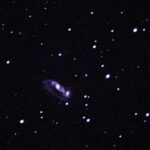 |
Arp 81 / NGC 6621 and 6622 | Spiral galaxies with large high surface brightness companions on arms | 2024-09-02 21:28:00 | Captured on a dark night but where clouds closed in and forced me to shut down early. Seeing was poor, and stars exhibited distorted shapes. Nevertheless, you can see clearly the pair of interacting spiral galaxies with one (6621) exhibiting a long arm separated from the spiral and connecting to the smaller one (6622), especially in the inverted image. The two certainly appear to be in the process of merging, and I would love to see a simulation of the relative motion which created the long, wrap-around separation of the arm. The bright, elongated object to the right of the arm-tip I take to be a distorted field star not a galaxy. Arp's remarks are "Companion resembles M 51 companion", which suggests a singular, large companion and confirms my field-star interpretation. |
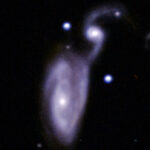 |
Arp 84 / Heron Galaxies / NGC 5394-5395 | Spiral galaxies with large high surface brightness companions on arms | 2024-05-31 23:23:00 | Finally a dark, moonless night to observe these galaxies. NGC 5395 is a near classic spiral galaxy only slightly distorted by its interaction with NGC 5394, which is an extreme barred spiral. Lovely. It certainly looks like a merger, or at least a strip of stars by 5395 from 5394, which presumably explains the barred spiral configuraiton. Often we see these galaxies by themselves: not often we get to see the theft in progress. It also appears, especially in my inverted image, that there is interaction between 5394 and a tiny galaxy down and right on the image, connected by a faint filament. IC 4356 is also nearby, but does not appear to be interacting with the other three. The nickname Heron Galaxies is apt, though I don't see it widely used. Arp's remarks, "Arcs of high S.B. around nucleus of companion" is certainly evident, and represents further confirmation of the "high surface brightness" classification. Anyway, a fun capture on a dark night. |
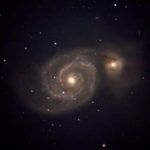 |
M51 / Arp 85 / Whirlpool Galaxy | Spiral galaxies with large high surface brightness companions on arms | 2024-02-19 15:52:00 | After a gap of 20 months Messier recorded M51 on January 11, 1774, roughly 3 months after his discovery (#22 so far): "Very faint nebula, without stars, near the eye of the Northern Greyhound [hunting dog], below the star Eta of 2nd magnitude of the tail of Ursa Major: M. Messier discovered this nebula on October 13, 1773, while he was watching the comet visible at that time". <--> As galaxies go, with modern equipment, this is a very bright and familiar target, which I've captured successfully multiple times. Feb 19, 2024 was one of the clearest evenings of the Winter, and decided to stay on it to achieve "near" astrophotography quality despite using EAA techniques. The two galactic centers and the connecting dust lanes are clearly evident. Just beautiful! We've included two "bonus" observations: first an observation using my EVO 9.25, early in my EAA career. The other on July 15, 2024 on a so-so night using my EdgeHD to capture it using Bin2 on my ASI294 camera over 37m, and processed in Affinity Photo. |
 |
Arp 86 / NGC 7752 and 7753 | Spiral galaxies with large high surface brightness companions on arms | 2024-09-02 20:28:00 | NGC 7753 is a barred spiral galaxy connecting SW (rotate clockwise from N to W) via a large arm/dust lane to a much smaller spiral galaxy NGC 7752. This certainly qualifies as a "high surface brightness" companion. It is, however, the only, obvious bright companion and begs the question why there appear to be two other extended filaments emanating from NGC 7753 (see inverted image in the gallery). Are these filaments explained by low brightness companions? Possibly. One extended filament curves NE (upwards and right) on from the top of 7753's disk towards two bright circles. Those are almost certainly Milky Way field stars, and not involved gravitationally at all. It's possible the upper arm is simply maintaining rotational symmetry with the lower arm ( I don't understand the physics well enough to know if that's possible). Alternatively, there are hints of low surface brightness companions: one located between the two field stars just described, and the other just W (below). In addition, an extremely faint filament continues to the WNW (down and slightly right). This connects to a tiny smudge of a possible galaxy roughly level with the bottom the compact spiral disk of NGC 7753. Visually, the curve is continued by the line of field stars paralleling SW back towards 7752, but I DO NOT believe any continuous filament connects them there. |
